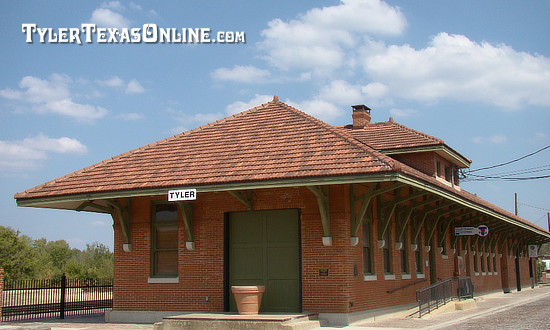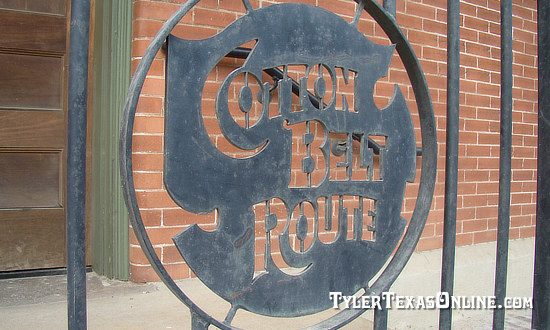 |
Tyler Tap Railroad
The Coming of the Railroad to Tyler
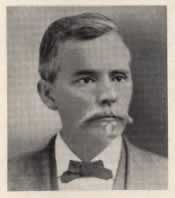 James P. Douglas, Tyler Tap Railroad Founder & President |
After the Civil War, Tyler became a center of agriculture and trade, and residents knew a railroad was the key to economic growth. But Tyler faced economic doom by the construction of two area railroads that were bypassing the city.
The Texas and Pacific Railway Company (T&P) was created by federal charter in 1871 with the purpose of building a southern transcontinental railroad between Marshall, Texas, and San Diego, California. This route was being built to the north of Tyler. The International Railroad and the Houston & Great Northern Railroad (H&GN) were building railways to the south, and later merged to form the International & Great Northern Railroad (I&GN) on September 30, 1873.
Tyler citizens recognized the need to construct a railroad to "tap" either the T&P or the International. One individual in particular took the lead in railroad construction. On returning home after the Civil War, Major James P. Douglas became interested in the fruit industry, and looked for faster means of shipping this commodity outside the Tyler area.
Tyler Tap Railroad
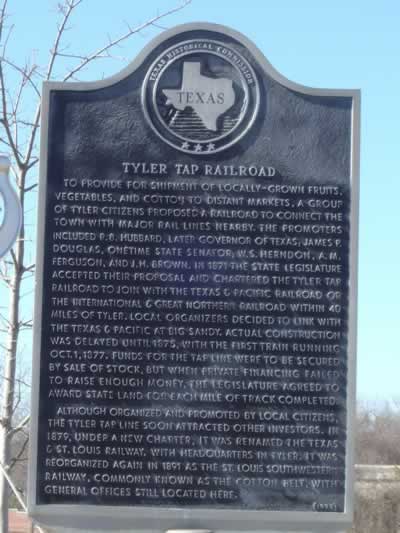 Tyler Tap Railroad Historic Marker in Tyler Texas near the Cotton Belt Depot Museum |
Therefore, in 1870, Douglas petitioned the Texas Legislature to pass a special act of incorporation granting him and others the right to locate, construct, own, operate, and maintain a railroad, for a distance not exceeding 40 miles, from Tyler to connect with another railroad.
The Tyler Tap Railroad Company was thus chartered on December 1, 1871, by a special act of the Twelfth Texas Legislature.
The charter authorized the construction of a railroad from Tyler, in Smith County, to a point no more than 40 miles away, and granted a right-of-way 200 feet wide, as well as the use of any natural resources on state land within five miles of the track. In 1873 the charter was amended to increase capitalization to provide for a route northward through Gilmer, Pittsburg, Mount Pleasant, and Clarksville. This amendment increased the projected mileage to 127. In return for right-of-way, each town was promised a depot located within one mile of their respective county courthouses.
Other railroad activity was occurring at the same time in Tyler, as the Houston and Great Northern completed its line through Tyler in 1873 on its route from Troup to Mineola, a 44-mile branch line between the International Railroad at Troup and the Texas & Pacific (T&P) Railroad at Mineola. The I&GN was merged into the Missouri Pacific (MP) system in 1956.
The charter stipulated that the railroad utilize the same gauge as the railroad to which it was to connect. The T&P was using the standard gauge track. Although $3,000,000 had been authorized for capital stock, less than $50,000 in shares were sold, making it necessary to consider a narrower gauge.
These financial difficulties dictated that a 3-foot gauge be used to economize the project. Construction finally began in the summer of 1875, but it took the company two years to build 21 miles of track to a connection with the Texas and Pacific (T&P) at Big Sandy (originally known as Big Sandy Switch). The connection there between the narrow gauge Tyler Tap and the standard gauge T&P would necessitate the use of parallel siding so that cargo could be transferred from line to the other.
On October 1, 1877, the Tyler Tap's only locomotive, named the Governor Hubbard, steamed into Tyler with the line's first train. The railroad's equipment included one passenger car and sixteen freight cars. The passenger train ran one round trip daily as there was no provision to run the train at night.
Although the Tyler Tap was built as economically as possible, it was not a financial success. Douglas was able to interest James W. Paramore, president of the St. Louis Cotton Compress Company, and his associates, in the Tyler Tap line. The St. Louis capitalists were attracted to the deal as they felt that an additional connection for the Tyler Tap might result in lower rates on cotton.
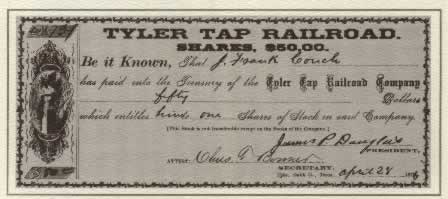 Tyler Tap Railroad Stock Share |
By charter amendment, the Tyler Tap was renamed the Texas and St. Louis Railway Company on May 14, 1879. On July 12, 1880, the company completed 107 miles of narrow-gauge railroad between Texarkana and Big Sandy, and by the end of the year an additional 37 miles from Tyler to Athens. The 38 miles from Athens to Corsicana opened in 1881, and an additional 102 miles between Corsicana and Gatesville in 1882.
The St. Louis Southwestern Railway (SSW), known by its nickname of "The Cotton Belt Route" or simply Cotton Belt, was organized on January 15, 1891. The Cotton Belt later acquired another area railroad, the Tyler Southeastern Railway, in 1899, creating a branch from Tyler through Gresham, Flint and Bullard to Lufkin via Jacksonville and Rusk.
By 1886 the little 21 mile railroad promoted by the citizens of Tyler had become part of a large rail system extending from Bird's Point, Missouri, to Gatesville, Texas. Tyler Tap's place in history as the beginning of the St. Louis Southwestern Railway Company was secured.
The crossing of the Cotton Belt and the I&GN (later MoPac) tracks remains today in downtown Tyler at the site of the Cotton Belt Depot (see photo below).
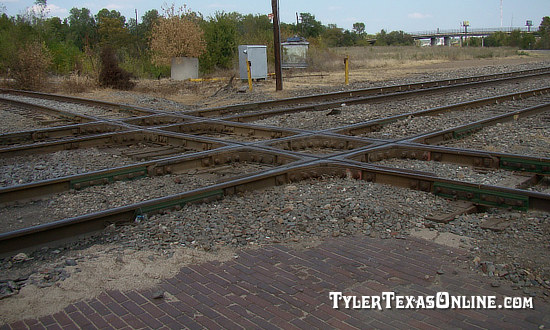 The crossing of the Cotton Belt and I&GN tracks in downtown Tyler, Texas (Staff Photo, September, 2011) |
|
To learn more about the depot and the history of the Cotton Belt in Tyler, we recommend a visit to Cotton Belt Depot Museum 210 East Oakwood Street in downtown Tyler, staffed by volunteers from the Cotton Belt Rail Historical Society, Tyler Tap Chapter |
|
Cotton Belt Menu |
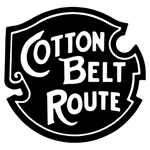 |
